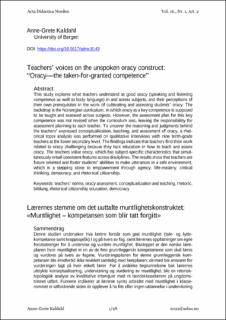| dc.contributor.author | Kaldahl, Anne-Grete | |
| dc.date.accessioned | 2022-06-08T07:57:52Z | |
| dc.date.available | 2022-06-08T07:57:52Z | |
| dc.date.created | 2022-05-23T12:40:42Z | |
| dc.date.issued | 2022 | |
| dc.identifier.issn | 2535-8219 | |
| dc.identifier.uri | https://hdl.handle.net/11250/2997817 | |
| dc.description.abstract | This study explores what teachers understand as good oracy (speaking and listening competence as well as body language) in and across subjects, and their perceptions of their own prerequisites in the work of cultivating and assessing students’ oracy. The backdrop is the Norwegian curriculum, in which oracy as a key competence is supposed to be taught and assessed across subjects. However, the assessment plan for this key competence was not revised when the curriculum was, leaving the responsibility for assessment planning to each teacher. To uncover the reasoning and judgments behind the teachers’ expressed conceptualization, teaching, and assessment of oracy, a rhetorical topoi analysis was performed on qualitative interviews with nine tenth-grade teachers at the lower secondary level. The findings indicate that teachers find their work related to oracy challenging because they lack education in how to teach and assess oracy. The teachers value oracy, which has subject-specific characteristics that simultaneously entail consistent features across disciplines. The results show that teachers are future oriented and foster students’ abilities to make utterances in a safe environment, which is a stepping stone to empowerment through agency, life-mastery, critical thinking, democracy, and rhetorical citizenship. | en_US |
| dc.language.iso | eng | en_US |
| dc.rights | Attribution-NonCommercial-NoDerivatives 4.0 Internasjonal | * |
| dc.rights.uri | http://creativecommons.org/licenses/by-nc-nd/4.0/deed.no | * |
| dc.title | Teachers' voices on the unspoken oracy construct: "Oracy-the taken-for-granted competence" | en_US |
| dc.type | Journal article | en_US |
| dc.type | Peer reviewed | en_US |
| dc.description.version | publishedVersion | en_US |
| dc.rights.holder | Copyright 2022 The Author(s) | en_US |
| dc.source.articlenumber | 2 | en_US |
| cristin.ispublished | true | |
| cristin.fulltext | original | |
| cristin.qualitycode | 1 | |
| dc.identifier.doi | 10.5617/adno.8143 | |
| dc.identifier.cristin | 2026491 | |
| dc.source.journal | Acta Didactica Norden (ADNO) | en_US |
| dc.identifier.citation | Acta Didactica Norden (ADNO). 2022, 16 (1), 2. | en_US |
| dc.source.volume | 16 | en_US |
| dc.source.issue | 1 | en_US |

